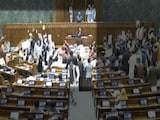Israel today denied reports of a ceasefire in Gaza to allow humanitarian aid to enter the Palestinian enclave and foreigners to flee to Egypt as the war between Israeli forces and Hamas entered the 10th day.
"There is currently no ceasefire and humanitarian aid in Gaza in return for removing foreigners," a statement from Israeli Prime Minister Benjamin Netanyahu's office said.
Convoys of humanitarian aid piled up at the Egypt-Gaza border, unable to cross into Gaza that has been under Israeli bombardment. An American official told AFP on Saturday that Egypt and Israel had agreed to allow US citizens to leave Gaza through the Rafah crossing, a report denied by Israel.
The Rafah border crossing is the only passage in and out of the Gaza Strip that is not under Israeli control. The crossing has been closed since Tuesday after Israeli airstrikes on Palestinian border posts.
History Of Rafah Crossing
The Ottoman-British agreement of October 1, 1906, established a border between Palestine, which was then ruled by the Ottoman Empire, and Egypt, which was then ruled by Britain. The border ran from Taba to Rafah.
1979 Egyptian-Israeli Peace Treaty
In 1979, The Egyptian-Israeli Peace Treaty restored the border to the line drawn in 1906. This meant that Egypt regained control of the Sinai Peninsula, while Israel kept the city of Gaza. Israeli forces began to leave the peninsula shortly after the treaty was signed.
After the last Israeli troops withdrew, the Rafah Crossing Point was opened as an international border for the first time ever, making the boundary both legally and practically international.
The current Gaza-Egypt border crossing was opened in 1982, after the Camp David Accords. However, Palestinians have been grappling with the uncertainty of Israel-controlled border crossings for years.
1994 Gaza-Jericho Agreement
The Gaza-Jericho Agreement in 1994, following the First Intifada, was a watershed moment that gave Palestine autonomy and created a new system of shared control over the Rafah Crossing. This system gave the Palestinian Authority (PA) some control over security and screening procedures, but Israel kept control over most of the crossing's security and operations, as well as the power to inspect and deny access to anyone. This part of the Agreement was later made null and void and replaced with almost the same language in the Oslo II Agreement.
The following year then-Israeli Prime Minister Yitzhak Rabin was assassinated in Tel Aviv by a Jewish right-wing extremist opposed to the Accords.
2000 Ariel Sharon Incident
In September 2000, right-wing Israeli politician Ariel Sharon visited the Al-Aqsa Mosque compound in Jerusalem's Old City, which is the third holiest site in Islam and revered by Jews as the Temple Mount, their most sacred site.
This was seen as "provocation" by Palestinians, triggering the Second Intifada. This further impacted the complexities of the Rafah Crossing.
In 2001, Israel barred Palestinian personnel from working at the Rafah Crossing, returning it to exclusive Israeli control. This was a direct result of the Second Intifada. Israel's exclusion of Palestinian workers would continue until its disengagement from Gaza four years later on September 8, 2005.
2005 Agreement on Movement and Access
In 2005, the Israeli government and the Palestinian Authority signed the Agreement on Movement and Access (AMA) bringing the crossing under "full" Palestinian control but with a catch. Under the agreement, Israel reserved the right to close the border and deny individuals from crossing it whenever it chooses.
On June 25, 2006, Palestinian militants took Israeli soldier Gilad Shalit prisoner. Israel closed the Rafah Crossing in response to the capture, and it remained closed for a year.
The Hamas takeover of Gaza prevented the AMA from being implemented, and the city was placed under permanent blockade. A week before that, Hamas, who had controlled the PA legislature since winning the 2006 election, broke away from the PA and seized control of Gaza. Between then and 2009, Egypt and Gaza opened the crossing infrequently and irregularly.
2011 Arab Spring
In 2011, after Egyptian President Hosni Mubarak, an opposer of Hamas, stepped down following the Egyptian Revolution. This ensured the reopening of the Rafah crossing on a regular basis. However, a General Abdel Fattah el-Sisi-led coup removed Egypt President Mohamed Morsi, a Hamas ally, in 2013, closed the Rafah crossing once again.
Covid
In 2020, following the outbreak of the coronavirus pandemic, Hamas shut the crossing, marking a rare occasion when a Palestinian government closed the border.
The following year, as international borders eased movement as the virus began to subside, Hamas and Egypt held talks in Cairo and reopened the crossing.















